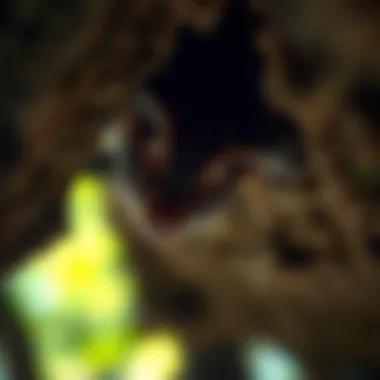The Effects and Management of White Nose Syndrome in Bats


Intro
White Nose Syndrome (WNS) has unfurled a shadow over the thriving bat populations across North America. This affliction, which was first identified in New York in 2006, has rapidly spread, wreaking havoc in its wake. As our ecosystems rely heavily on bats for pest control, pollination, and seed dispersal, understanding the implications of WNS becomes all the more crucial. Each of these nocturnal mammals plays a vital role in maintaining a healthy balance in our forests. When one element of the system suffers, the repercussions ripple outward.
This article seeks to explore the multifaceted nature of WNS, ranging from its origins to its biological mechanisms, ultimately connecting it with the broader ecological impacts. There’s a nuanced landscape of issues at play, often overlooked in the broader environmental discourse. From the realm of policy and conservation strategies to the intricate web of interspecies relationships, we aim to provide an in-depth examination tailored for forestry professionals and environmental stewards.
By investing time in understanding WNS, we not only foster better management practices but also advocate for the stability of the ecosystems on which our livelihoods and natural heritage depend. Let's embark on this exploration together, diving deep into the intricate impacts of White Nose Syndrome and the proactive strategies that can lead us toward recovery.
Prelude to White Nose Syndrome
The ongoing plight of bat populations due to White Nose Syndrome (WNS) is an urgent concern in the realm of wildlife health and conservation. This fungus-driven epidemic not only threatens the survival of several bat species but also poses significant repercussions for their ecosystems. The effects ripple outward—impacting the balance of natural systems that rely on bats for various ecological services such as insect control and seed dispersal.
Understanding WNS requires a multifaceted approach, recognizing both the biological factors at play and the broader environmental conditions contributing to its spread. This section aims to lay the groundwork for exploring these aspects, emphasizing the importance of comprehensively addressing WNS for a healthier environment.
Defining White Nose Syndrome
White Nose Syndrome is defined as a devastating fungal disease caused primarily by the pathogen Pseudogymnoascus destructans. The name derives from the distinctive white fungal growth that appears on the muzzles and wings of infected bats, particularly during hibernation, a crucial period when their energy reserves are low. WNS was first documented in the United States in 2006, mainly affecting bats in caves where they roost during the winter months. Infection leads to abnormal behaviors, including premature awakening from hibernation.
Symptoms can vary, but many bats exhibit weight loss, diminished immune response, and even erratic flight patterns before dying, usually from starvation or exposure. Given these characteristics, the disease has spread rapidly, resulting in declines in bat populations reaching up to 90% in some areas. The accelerated mortality rates have raised alarms among biologists and conservationists alike, underscoring the urgent need for effective management strategies.
Historical Context and Discovery
The discovery of White Nose Syndrome brought a paradigm shift in how scientists view wildlife disease and conservation priorities. Initially reported in New York, the syndrome’s rapid infiltration into multiple states highlighted the vulnerability of bat species. The disease seems to favor cold, humid environments, making caves an ideal breeding ground for the fungus.
Historically, the conservation community has focused primarily on species-specific preservation tactics. However, WNS forced an evaluative shift, compelling researchers to look into broader environmental health issues. By understanding how WNS interacts with various ecological and anthropogenic factors, conservation efforts can adapt and evolve. Moreover, the historical context of this disease raises critical reflections on how humans have altered habitats and possibly exacerbated the conditions favoring WNS.
"By recognizing the historical and ecological factors contributing to White Nose Syndrome, we open avenues for more holistic solutions that cater not only to bats but to the ecosystems relying on their existence."
Causes of White Nose Syndrome
Understanding the Causes of White Nose Syndrome (WNS) is crucial for unraveling its impact on bat populations and ecosystems. This fungal disease, primarily affecting North American bats, results from complex interactions between pathogens and environmental elements. Awareness of these factors informs conservation efforts and effective management strategies. Grasping the underlying causes not only highlights the risks involved but also guides research and public policy aimed at combating the disease.
Fungal Pathogens Involved
White Nose Syndrome is caused by the Pseudogymnoascus destructans fungus. This pathogen thrives in cold, damp areas, which is why it impacts bats during their hibernation period. The fungus was first identified in New York in 2006, and its presence in hibernacula has shown to be lethal to infected bats. When bats awaken from hibernation due to this infection, they exhibit abnormal behaviors, like flying around in cold temperatures, leading to dehydration and starvation.
Some key points to consider about the fungal pathogens are:
- Adaptability: Pseudogymnoascus destructans can survive in low temperatures, allowing it to persist across various conditions.
- Transmission: The fungus can spread through direct contact with infected bats or indirectly via contaminated surfaces in roosting sites.
- Symptoms: Infected individuals may show signs like white fungal growth on their noses and wings, severe weight loss, and behavioral abnormalities.
"Wildlife health is intricately tied to our ecosystems; understanding diseases like WNS is paramount for effective stewardship of both species and habitats."
Environmental Factors Contributing to Outbreaks
Several environmental conditions can exacerbate the spread of WNS. For instance, temperature fluctuations in caves and abandoned mines where bats hibernate can influence the fungus's activity positively or negatively. Other environmental factors include:
- Humidity Levels: High humidity supports fungal growth, creating a conducive environment for the pathogen to thrive.
- Geographic Distribution: Regions with numerous bat species and favorable hibernacula offer ideal scenarios for the fungus to establish itself.
- Human Impact: Activities such as cave exploration and renovation can inadvertently spread the fungal spores, making it essential for researchers and the public to follow appropriate guidelines when entering bat habitats.
These factors underscore the complexity of managing and mitigating WNS, calling for comprehensive research and joint conservation efforts to protect North American bat populations.
For more on the ecological impacts, you may refer to National Park Service and U.S. Fish and Wildlife Service.
Understanding these causes not only sheds light on the disease mechanisms but also empowers us to take informed steps towards effective management and conservation.
Effects on Bat Populations
Understanding the effects of White Nose Syndrome (WNS) on bat populations holds immense significance. This perspective not only highlights the immediate consequences of a devastating disease but also showcases the broader implications for ecological balance. As bats serve crucial roles in various ecosystems, any decline in their population densities could reverberate throughout many layers of environmental health. With this in mind, the urgency to delve into the specifics of population declines and behavioral changes cannot be overstated.


Population Declines and Extinction Risks
The sheer scale of population declines linked to WNS has raised alarm bells among conservationists and ecologists alike. Reports indicate that the North American bat population has faced staggering losses, with some species, like the Little Brown Bat, experiencing declines of over 90% in certain areas. This catastrophic reduction poses an imminent threat to their survival. The potential for extinction becomes more than a mere statistic; it is a reality staring us in the face.
"Without immediate action, iconic bat species may soon become ghosts of the past, serving only as cautionary tales for future generations."
The reasons for these declines are multifaceted. First, the way WNS disrupts hibernation patterns leaves bats vulnerable to exhaustion, decreased reproductive success, and increased mortality rates. It's a harsh cycle: as bats awaken too early and subsequently deplete their fat reserves, they struggle not just for survival but for their very existence.
This situation is compounded by environmental pressures, such as habitat loss and climate change, creating a one-two punch that many bat species simply can't withstand. The possibility of extinction is not confined to individual species but is a broader concern that threatens entire ecosystems where these bats play indispensable roles—like controlling insect populations which, if unchecked, can lead to agricultural pests booming.
Behavioral Changes in Infected Bats
Behavioral alterations in bats afflicted with WNS add another layer of complexity to the crisis. Infected bats exhibit notable changes that challenge their ability to function in their natural environment. For example, disruption of roosting behaviors results in less effective social interactions, which are vital for mating and colony dynamics. Bats are social creatures, and any disturbance in social structures can lead to more significant population woes. Some species showcase unusual daylight activity, which places them at risk from predators and increases their risk of encounters with human habitats.
Additionally, these behavior shifts often translate into poor foraging habits. When bats struggle to maintain energy due to poor feeding—linked in part to their disrupted circadian rhythms—consequences extend to ecosystem health. An abundance of insects can lead to agricultural challenges and disrupted food webs.
In sum, the effects of WNS on bat populations extend far beyond individual creatures. The interconnectedness of ecosystems means that any shifts in bat behavior and population sizes may ripple through the environment, leading to unforeseen consequences. As we strive to understand these dynamics, fostering proactive conservation strategies becomes essential.
Ecological Consequences
The implications of White Nose Syndrome (WNS) reach far beyond the bat population itself. Understanding the ecological consequences of this devastating disease offers profound insights into the fate of ecosystems dependent on bats. These nocturnal creatures play pivotal roles in various ecological functions. Their decline does not merely signify a reduction in their species but raises significant alarms for biodiversity and ecological health. Exploring this topic underscores the interconnectedness of life forms within habitats and the intricate balance that sustains them.
Role of Bats in Ecosystems
Bats are often dubbed as the unsung heroes of our ecosystems. They contribute considerably to pest control, seed dispersal, and pollination, acting as crucial custodians of their habitats. A single bat can consume thousands of insects in one night, contributing to natural pest management that keeps agricultural pests at bay. For instance, studies have shown that one species, the little brown bat, can devour over 600 mosquitoes in an hour. Without such diligent insectivores, we might see an exponential rise in pest populations, which could threaten crops and negatively affect local economies.
- Natural Pest Control: Bats help mitigate populations of insects that damage crops and spread diseases, decreasing the need for pesticide applications, which brings its own set of environmental risks.
- Seed Dispersal: Fruit-eating bats, like those in the tropics, play a significant role in seed dispersal, promoting forest regeneration and maintaining plant diversity.
- Pollination: Certain bat species are vital pollinators for diverse plants, including agave and various tropical fruits, showcasing their critical role in sustaining plant life.
The potential decline of bats due to WNS could spur a domino effect that disrupts these functions. As we witness shifts in population dynamics, the absence of bats may lead to substantial changes in species interactions, ultimately affecting the structure of entire ecosystems.
Impacts on Insect Population Control
The relationship between bats and insect populations is as intricate as it is essential. With the advent of White Nose Syndrome, changes in bat populations create a ripple effect through food webs. The decline in bat numbers results in unchecked insect populations that can lead to ecological imbalances. More insects mean more crop destruction and an increase in vector-borne diseases, further stressing ecosystems and human health.
- Increased Crop Damage: Unsuitable pest levels can devastate farms, leading to not just loss of yield but also economic strain on farmers.
- Spread of Diseases: More insects often coincide with increases in diseases carried by pests, such as Lyme disease and West Nile virus.
Research emphasizes this clear connection, revealing that a substantial decrease in bat numbers could lead to a rise in certain pests by upwards of 300%. This susceptibility places both agriculture and public health at significant risk.
"The imbalance in predator and prey relationships caused by the reduction of bat populations has far-reaching consequences for ecosystem stability."
As WNS continues to threaten bats globally, it is imperative to recognize that their well-being is intricately tied to the ecological framework. Addressing WNS is not merely about saving bats; it’s about preserving the delicate balance of life that has evolved over millennia. Royally recognizing this will guide us towards more effective conservation strategies and encourage a deeper respect for the critical roles that species play in maintaining the health of our planet.
For further insights on the importance of bats in our ecosystems and their role in pest control, look into resources such as National Geographic and The Nature Conservancy. Additionally, the U.S. Fish & Wildlife Service provides in-depth data on conservation efforts.
Current Research Efforts
The quest to understand and combat White Nose Syndrome (WNS) has spurred a wave of research initiatives. Given the profound impact of this fungal disease on bat populations and the broader ecosystem, ongoing studies are an essential part of the narrative. Current research efforts are important not only for uncovering the biological and genetic underpinnings of WNS but also for exploring its varied ecological implications.
Biological Studies on Disease Mechanisms
Biological studies play a pivotal role in unraveling the intricate mechanisms by which WNS affects bats. The key focus of these studies is Pseudogymnoascus destructans, the fungus responsible for the syndrome. Researchers are delving into how this pathogen interacts with its hosts at the cellular and molecular levels, seeking to understand how it invades bat tissues and affects their hibernation cycles.
Recent findings indicate that environmental conditions, such as humidity and temperature, can significantly influence the fungus's virulence. For instance, under specific conditions, Pseudogymnoascus destructans can proliferate rapidly, exacerbating its harmful effects on bats. Studies highlight the importance of examining the fungus's lifecycle and the stages at which it might be most vulnerable to intervention. The integration of advanced microbiological techniques enables scientists to conduct a detailed characterization of how the fungus operates, ultimately guiding the development of targeted interventions.
"By understanding the disease mechanisms, we can formulate effective countermeasures, not only in terms of treatment but also in preventative strategies."


Genetic Research on Bat Resistance
Another crucial facet of current research is the focus on the genetic resistance of certain bat populations to WNS. Some species, such as the little brown bat, are significantly impacted, while others show a higher level of resilience. Understanding the genetic basis for this resistance could illuminate pathways for conservation efforts. Scientists are utilizing genomic techniques to identify specific genes associated with fungal resistance.
One study highlighted the role of immune response genes in providing a barrier against Pseudogymnoascus destructans. Bat populations that exhibit a stronger immune response might be key in developing conservation strategies, as they can potentially serve as a reservoir of resistance traits. In this respect, it is pivotal to conduct comparative genetic studies across various bat species to identify adaptive traits.
Researchers are also investigating gene-editing technologies, which could enable the enhancement of resistance in vulnerable populations. The ethical implications of such research continue to be debated, but the potential for saving species that are currently on the brink of extinction offers a compelling case for advancing these studies.
Conservation Strategies
The management and mitigation of White Nose Syndrome (WNS) in bat populations hinges significantly on effective conservation strategies. The implementation of these strategies is paramount not only for preserving the diverse species of bats but also for ensuring the ecological balance within their habitats. Successful conservation measures can counteract the alarming decline of bat populations while promoting the restoration of their vital role in ecosystems.
Monitoring and Surveillance Practices
Monitoring and surveillance practices play a critical role in understanding the spread and impact of WNS. They allow researchers and conservationists to track infection rates and observe changes in bat behavior. Such data can pinpoint areas most affected by the disease, which aids in deploying targeted interventions. Here are some key components of effective monitoring:
- Regular population surveys: Conducting routine counts helps in assessing bat population dynamics. These surveys can be both visual and auditory, especially during the bats' active seasons.
- Health screenings: By regularly testing bat populations for WNS, researchers can gather essential data regarding the prevalence of the fungus Pseudogymnoascus destructans, which causes the disease. This also helps pinpoint genetic resistance among bats.
- Tracking migration patterns: Bats often migrate, and understanding these patterns can assist in identifying potential infection hotspots. This information can be vital when integrating local conservation efforts with regional ones.
"If we don’t keep a close eye on these creatures, we risk losing not just bats, but the balance they bring to our ecosystems."
From those surveys and screenings, conservationists gather insights that directly impact management strategies. Protecting crucial roosting sites and limiting disturbances during critical periods are vital steps derived from monitoring efforts.
Habitat Management Techniques
Habitat management techniques are equally important in combating the effects of WNS. These methods aim to enhance and protect the environments that bats depend on for survival. Here's a closer look at some essential habitat management practices:
- Preserving roosting sites: Caves and abandoned buildings provide essential roosting environments for bats. Conservationists strive to protect these locations from human interference and development. It’s crucial to limit access to these areas, especially during hibernation seasons, to prevent stress on bat populations.
- Creating artificial habitats: In areas where natural roosting sites have been compromised, constructing bat houses or enhancing existing structures can offer safe alternatives. This can help mitigate population declines in the short term while longer-term strategies are being deployed.
- Land use planning: Engaging with land-use planners allows conservationists to develop strategies that protect critical habitats from urban sprawl and agricultural expansion. By integrating bat conservation into land-use policies, we can safeguard their habitats alongside ecological integrity in broader landscapes.
- Restoration of wetlands and forests: Enhancing ecosystems that support insect populations can indirectly aid bats, as these creatures rely heavily on insects for food. Restoring wetlands and forests creates a balanced environment for both bats and their prey.
Together, these strategies are vital in addressing the complex challenges posed by White Nose Syndrome. The integration of monitoring practices and habitat management ensures a holistic approach to bat conservation, creating pathways for healthier populations and resilient ecosystems. Through collaboration among researchers, conservationists, and local communities, we can encourage sustainable practices that triumph over the challenges posed by this devastating disease.
For additional resources on bat conservation and monitoring practices, consider exploring the following links:
- National Park Service: Bats
- US Fish and Wildlife Service: White-nose Syndrome
- Bat Conservation International
- BBC Wildlife: Bats and Conservation
Policy Implications
The ramifications of White Nose Syndrome (WNS) on bat populations extend beyond biology into the realm of policy, demanding immediate attention from legislators and stakeholders alike. As we begin to unravel the complexities of WNS, we recognize that effective policy can play a critical role in safeguarding bat populations, which are essential to maintaining ecological balance. Exploring the legal and community frameworks surrounding bat conservation leads to an understanding of how coordinated efforts can yield significant protection for these vulnerable mammals.
Legislation Affecting Bat Conservation
Legislation tailored for bat conservation has emerged as a vital aspect in the battle against WNS. The Endangered Species Act (ESA) in the United States, for instance, provides a framework for protecting species at risk of extinction, including various bats impacted by WNS. This legislation enables conservationists to advocate for research funding, habitat preservation, and other necessary actions required to combat the disease.
However, challenges in drafting and enforcing effective policies often arise. Legislative measures should be agile, adaptable to new research findings, especially as we discover more about the pathogens involved in WNS and their environmental triggers. Moreover, local and state laws, together with federal legislation, must align to create a comprehensive protection strategy. Here are some significant considerations in this area:
- Funding for Research: Ensuring legislation allocates resources to study WNS thoroughly.
- Habitat Protection: Policies should prioritize preserving the caves and roosting sites essential for bats, particularly those identified as having historical significance.
- Public Awareness Campaigns: An emphasis on educational programs can ensure that communities are informed and involved.
A detailed examination of legislative actions shows varying degrees of effectiveness. For a more cohesive approach, cooperation among state wildlife agencies, federal organizations, and non-profits is necessary to bolster laws that are currently in place.
Engagement with Local Communities
Engaging local communities is crucial to the success of any policy initiative aimed at bat conservation. Bats often face misunderstanding or fear among the public, leading to negative attitudes that can hinder conservation efforts. Communities that see the benefits of bats, such as natural pest control and ecosystem health, are more likely to support protective measures. This symbiotic relationship can be nurtured through:
- Educational Initiatives: Schools and community centers can host workshops explaining the significance of bats and the threats posed by WNS, fostering a more positive image of these creatures.
- Citizen Science Projects: Encouraging local residents to participate in monitoring bat populations helps raise awareness and builds a sense of ownership over conservation efforts.
- Local Partnerships: Collaborations with local businesses and organizations boost mobilization efforts, helping to fund initiatives or events geared toward bat conservation and awareness.
Through well-tailored engagement, policy-makers can reinforce the importance of bats and their ecosystems, resulting in a community-driven approach that fosters resilience against threats like WNS. It is through such grassroots involvement that lasting solutions can be cultivated, ensuring the sustainability of bat species for future generations.
Future Directions in WNS Research


The exploration of future avenues in White Nose Syndrome (WNS) research stands as a beacon of hope and innovation amidst the turmoil that bats are facing. Understanding where research is headed allows us to prioritize interventions that can ensure survival and health of bat populations. Emerging technologies in the realm of disease management and cross-species research signal the potential for significant advancements in the fight against WNS. This section encapsulates the current focus and potential breakthroughs that may redefine how we approach bat conservation in light of this debilitating syndrome.
Emerging Technologies for Disease Management
The integration of cutting-edge technologies is crucial for managing White Nose Syndrome effectively. Various techniques are being evaluated for their potential to inhibit the growth of the Pseudogymnoascus destructans fungus, alongside strategies for boosting bat immunity. Some notable innovations include:
- Genetic Engineering: Genetic modification of fungal strains could help create attenuated variants that might compete with pathogenic forms without harming bats.
- Fungal Inhibition Products: New formulations that target fungal growth on bats’ skin are being tested. These products aim to create a protective barrier, possibly reducing infection levels.
- Drone Surveillance: The use of drones equipped to monitor bat habitats can assist in real-time surveillance of populations, breeding grounds, and fungal load levels without disturbing colonies.
- Predictive Modeling: Utilizing machine learning algorithms helps in predicting outbreak patterns based on climatic and environmental data. This could guide preemptive action in vulnerable areas.
As these technologies advance, they will not only require collaboration among scientists but also adherence to ethical standards in genetic interventions and habitat disturbances.
Potential for Cross-Species Research
Delving into cross-species research may hold critical insights into understanding WNS better. By studying the immune responses of related species to similar fungal pathogens, researchers can uncover valuable information to apply to bat conservation. Considerations in this field include:
- Related Species Responses: Analyzing how other mammals respond to Pseudogymnoascus destructans may illuminate pathways for developing resistance in bats.
- Shared Ecology: Insights into disease dynamics among other wildlife species can elucidate ecological interactions that influence the spread and impact of WNS on bat populations.
- Comparative Genomics: Leveraging genomic tools from different species to identify genetic markers for resistance could lead to breakthrough discoveries in how to fortify bat health against infections.
"Understanding the links between species and diseases strengthens conservation strategies and minimizes the risk of decline in affected populations."
- Collaboration and Data Sharing: Fostering partnerships among researchers globally can enhance data sets and optimize the effectiveness of researched solutions. Collaboration can streamline knowledge dissemination, allowing for quicker adaptation of practices to counteract emerging threats.
In summary, both emerging technologies for disease management and cross-species research highlight a landscape rich with possibilities. By focusing on these directions, we engage not only in the preservation of bats but also in the intricate balance of our ecosystems as a whole. Continued effort in these areas is crucial for a sustainable future.
Public Awareness and Education
Public awareness and education regarding White Nose Syndrome (WNS) are crucial components in the ongoing effort to protect bat populations and maintain healthy ecosystems. Engaging the public not only raises understanding but also yields support for various conservation initiatives. The issue of WNS is not merely a scientific concern but a community challenge that requires cooperation among various stakeholders, from individual citizens to large organizations.
Education empowers individuals with the knowledge needed to recognize the signs of WNS and its repercussions on bat health and biodiversity. Increased awareness can galvanize communities to participate in monitoring efforts and reporting sick or dead bats, which is invaluable in tracking the spread of this disease. Furthermore, a well-informed public is more likely to support legislation aimed at bat conservation and habitat protection.
Importance of Public Engagement in Conservation
The role of public engagement in conservation cannot be understated. When people understand the intricate relationships between bats and the ecosystems they inhabit, they are more inclined to take action. Public efforts can lead to increased funding for research initiatives, volunteer participation in monitoring programs, and the promotion of bat-friendly practices at local levels. Here are several points highlighting the importance of public engagement:
- Fostering Community Responsibility: By instilling a sense of responsibility towards local wildlife, communities can become stewards of their environments, actively participating in preservation efforts.
- Networking Opportunities: Educational workshops or community events can connect experts with locals, which makes room for the exchange of insights, strengthening community bonds.
- Behavioral Change: Public campaigns can shift perspectives and influence behaviors, persuading individuals to adopt practices that benefit both bats and ecosystems.
- Synergistic Impact on Conservation Policies: A well-informed public can serve as a catalyst for policy change, informing lawmakers about the community's values and priorities relating to wildlife conservation.
Resources for Educators and Stakeholders
To facilitate the spread of information, various resources are available for educators and stakeholders. The emphasis on educating both young and adult audiences is paramount for long-term conservation success. Here are some useful tools and resources that could enhance educational endeavors:
- National Wildlife Federation (NWF): Their website offers resources tailored for educators, including lesson plans and activities focused on bat conservation. (https://www.nwf.org)
- U.S. Fish & Wildlife Service: They provide comprehensive material on WNS, offering guidelines for educators on teaching about bat conservation and the significance of biodiversity. (https://www.fws.gov)
- Bat Conservation International: This organization is dedicated to bat conservation, providing resources, articles, and partnerships aimed at educating people about the importance of bats and the threats they face. (https://www.batcon.org)
- Local Wildlife Rehabilitation Centers: Many regional centers have outreach programs and can offer live demonstrations, which can be particularly engaging for school-aged children.
"Connecting with the public fosters a sense of shared responsibility in conservation, transforming the way communities interact with their environment."
In summary, the synergy between public awareness, education, and bat conservation will ensure that communities understand the significance of bats in maintaining ecological balance. By creating pathways for engagement and promoting resources, we can build a foundation for sustainable conservation efforts.
Culmination
The discussion surrounding White Nose Syndrome (WNS) emphasizes the urgent need for effective management strategies and conservation efforts. As we’ve explored throughout the article, WNS isn’t just a bat issue; it poses substantial threats to ecological balance and biodiversity. The far-reaching impacts of declining bat populations reach into various sectors, affecting pest control, pollination, and even the broader health of forest ecosystems.
In synthesizing the information, it becomes clear that successful mitigation of WNS hinges on an integrative approach that combines research, public awareness, and policy advocacy.
Key Elements of the Epilogue:
- Holistic Understanding: Acknowledging that public health, agriculture, and forestry all intersect with bat conservation
- Collaboration: Encouraging cooperation among scientists, conservationists, and local communities to strengthen efforts
- Policy Development: Influencing legislation to support research initiatives and funding for bat conservation projects
The benefits of properly understanding and managing WNS cannot be overstated. It’s essential for sustaining not just bat populations but the ecosystems they inhabit. Given that bats serve as natural insect controls, their decline can lead to a surge in pest populations, consequently impacting crops and forestry health. As such, addressing WNS with strategies that also integrate the local community’s interests can help foster a synergistic approach that yields long-term benefits.
"The fate of the bat is inextricably linked to the fate of the forest, reminding us that we are all part of this shared ecosystem."
For further reading on the importance of bat conservation and their roles in ecosystems, check out these resources:
- Bat Conservation International
- U.S. Fish & Wildlife Service
- National Park Service
- British Ecological Society
- Wikimedia on Bats and Ecosystems















